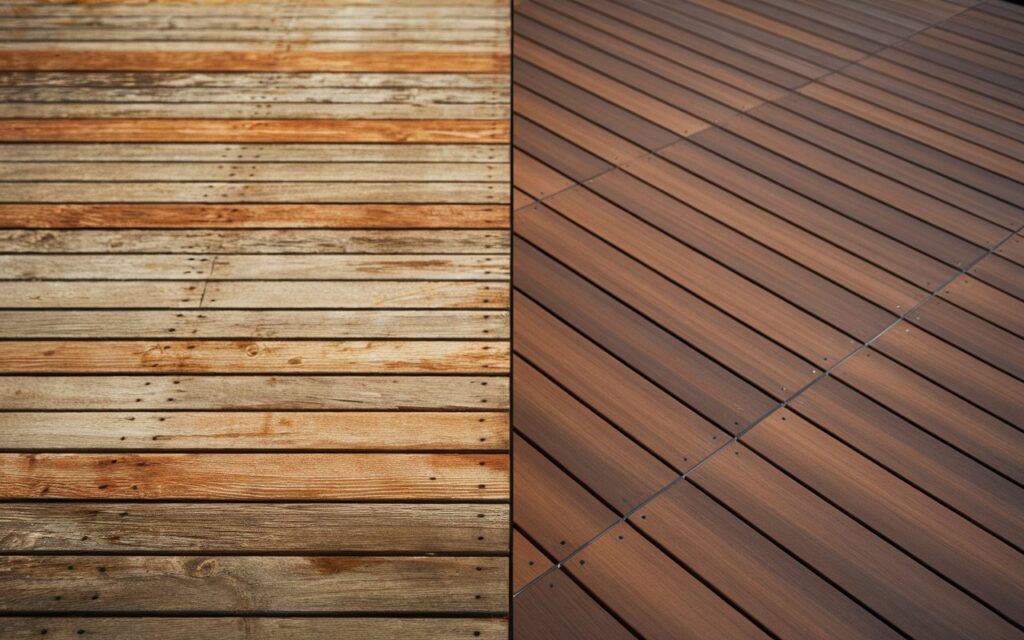Building or upgrading a deck is one of the most effective ways to enhance your outdoor living space, increase property value, and create a beautiful space for relaxing or entertaining. But before construction begins, homeowners must make one of the most important decisions in the entire process: choosing between wood and composite decking.
Both materials offer unique strengths, design benefits, and long-term considerations. Understanding the pros and cons of each can help you choose the right decking material based on your budget, maintenance preferences, climate, and lifestyle. Below is a complete guide to help you make a confident, informed decision.
What Is Wood Decking?
Wood decking is the classic material used for decades in residential outdoor spaces. Popular wood types include pressure-treated lumber, cedar, redwood, and tropical hardwoods like ipe or teak. Wood is known for its natural beauty, warm tones, and traditional appeal.
What Is Composite Decking?
Composite decking is a manufactured product made from a blend of recycled plastic, wood fibers, and binding agents. Modern composite boards are engineered for durability, low maintenance, and long-lasting performance, making them a popular choice for homeowners seeking convenience and longevity. Homeowners in Melbourne looking for reliable decking materials can also browse options from local decking specialists.
Pros and Cons of Wood Decking
✔ Pros of Wood Decking
1. Natural and Timeless Aesthetic
Nothing matches the classic look and feel of real wood. Its organic texture, grain patterns, and color variations make each deck unique. For homeowners seeking authenticity, wood is hard to beat.
2. Cost-Effective Upfront
Wood decking—especially pressure-treated lumber—is often more affordable initially compared to composite. This makes it an attractive option for budget-conscious projects or small deck installations.
3. Easy to Customize
Wood can be easily cut, stained, sanded, and painted to match your preferred style. Whether you want a rustic aesthetic or a contemporary look, wood offers versatile design flexibility.
4. Repair-Friendly
Scratches, dents, and stains on wood can typically be sanded out or refinished, making it relatively simple to restore its original appearance.
✘ Cons of Wood Decking
1. Requires Frequent Maintenance
Wood must be stained, sealed, or painted every 1–3 years to protect it from moisture, fading, mold, and insect damage. Over time, maintenance costs can exceed initial savings.
2. Vulnerable to Weathering
Rain, snow, UV rays, and humidity can cause wood to rot, warp, crack, or splinter—especially if poorly maintained or exposed to harsh climates.
3. Shorter Lifespan
Even premium hardwoods often last between 10–20 years. Without proper maintenance, that lifespan can shrink significantly.
4. Insect and Pest Risks
Termites, carpenter ants, and wood-boring insects can damage natural wood, particularly in humid or wooded areas.
Pros and Cons of Composite Decking
✔ Pros of Composite Decking
1. Extremely Low Maintenance
Composite boards never need painting, staining, or sealing. Occasional washing with soap and water is generally enough to keep them looking new. This makes composite ideal for homeowners who want hassle-free long-term performance.
2. Highly Durable and Weather-Resistant
Composite decking is engineered to resist fading, rotting, warping, mold growth, and insect damage. It performs well in extreme temperatures and high-moisture environments.
3. Long Lifespan
Most high-quality composite decking lasts 25–30 years or more. Many manufacturers offer long-term warranties, making it a solid long-term investment.
4. Wide Range of Colors and Styles
Composite comes in various colors, grain patterns, and finishes that mimic natural wood while offering modern advantages. You can choose from contemporary shades, rich natural tones, or sleek, minimalist designs.
5. Environmentally Friendly Options
Many composite products are made from recycled materials, making them an eco-conscious choice for sustainable building.
✘ Cons of Composite Decking
1. Higher Initial Cost
Composite decking typically costs more upfront than pressure-treated wood. However, the reduced maintenance and longer lifespan often offset the initial investment.
2. Can Expand or Contract in Extreme Temperatures
While composite resists many outdoor elements, prolonged heat or cold can cause slight expansion or contraction. Proper installation minimizes this issue.
3. Harder to Repair
Unlike wood, composite cannot be easily sanded or refinished. Deep scratches or stains may require board replacement.
4. Can Become Hot Under Direct Sun
Certain composite boards absorb heat more easily than natural wood, which may make the surface warm under intense sunlight.
Which Decking Material Should You Choose?
The right choice depends on your priorities:
- If you prioritize natural beauty and lower upfront costs: wood is a great option.
- If you prefer long-term durability with minimal maintenance: composite decking is the better choice.
- For harsh climates or high-moisture environments: composite often outperforms wood.
- For custom aesthetics and flexible refinishing: wood offers unmatched versatility.
Ultimately, think long-term. Compare installation costs, maintenance commitments, climate factors, and how you plan to use your outdoor space. Making the right choice now ensures your deck stays beautiful, safe, and functional for years to come.

